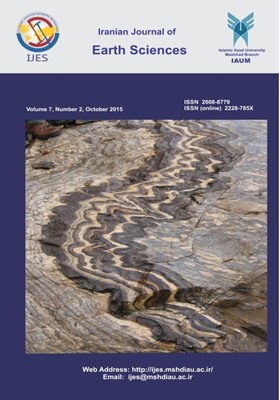Mineralogical and geochemical investigations of chromite ores from ophiolite complexes of SE Iran in terms of chrome spinel composition
الموضوعات :Jamal Tarrah 1 , Zahra Abedpour 2 , Karl Strauss 3 , Thomas Schirmer 4 , Kurt Mengel 5
1 - Islamic Azad University, Bandar Abbas Branch, Geology Department, Bandar Abbas, Iran
2 - Islamic Azad University, Bandar Abbas Branch, Geology Department, Bandar Abbas, Iran
3 - Institute of Mineralogy-Geochemistry and Salt Deposits, University of Clausthal, Germany
4 - Institute of Mineralogy-Geochemistry and Salt Deposits, University of Clausthal, Germany
5 - Institute of Mineralogy-Geochemistry and Salt Deposits, University of Clausthal, Germany
الکلمات المفتاحية: chemical composition, Ophiolite, Mineralogy, Microprobe, Spinel, SE Iran,
ملخص المقالة :
Ten chromite ores from ophiolite complexes in SE Iran were analyzed mineralogically by XRD, chemically by XRF, and mineral chemistry by EPMA. The identified paragenesis of silicate minerals of chromite ores with the X-ray diffraction is pronounced differently. It consists of secondary phases formed as serpentine, Cr-containing chlorite (kaemmererite), chromic garnet (uarovite) with preserved partly primary minerals of peridotite parent rocks such as olivine and diopside. From the total chemical analysis by XRF results, a good correlation exists between the Cr2O3 and SiO2 content (as an index of the sum of the silicate minerals). This allows an easy decision for mine ability of chrome ores. In a relatively good correlation are also the Mg and Fe oxide contents. The mineral chemisty (EPMA analysis ) of spimel mineral provides valuable information about the the octahedral layer of the spinel,. The results of the microprobe analysis show a variation in the chemical composition of the spinel phase of a mixed crystal formation consisting of: chromite (Fe2+Cr2O4), magnesiochromite (MgCr2O4), spinel (MgAl2O4), and hercynite (Fe2+Al2O4). This becomes even more complex by the mixed crystal relationship with picotite [(Mg, Fe2+)(Cr,Al,Fe3+)2O4], which contains Fe3+ in the tetrahedral position. The chrome spinel vary inCr-numbers [100 ×(Cr / Cr + Al) = 75-92] and Mg-numbers [100 * (Mg / Mg + Fe2+) = 38-57]. The partition of iron between Fe3+ und Fe2+ was made by assuming normal spinel structure, using the formula AB2O4. Correlations of microprobe analysis indicate that the mineral chemistry of the studied spinel is characterized mainly by the divalent elements of Mg and Fe2+ in the A position and trivalent elements Cr and Al in the B position.


